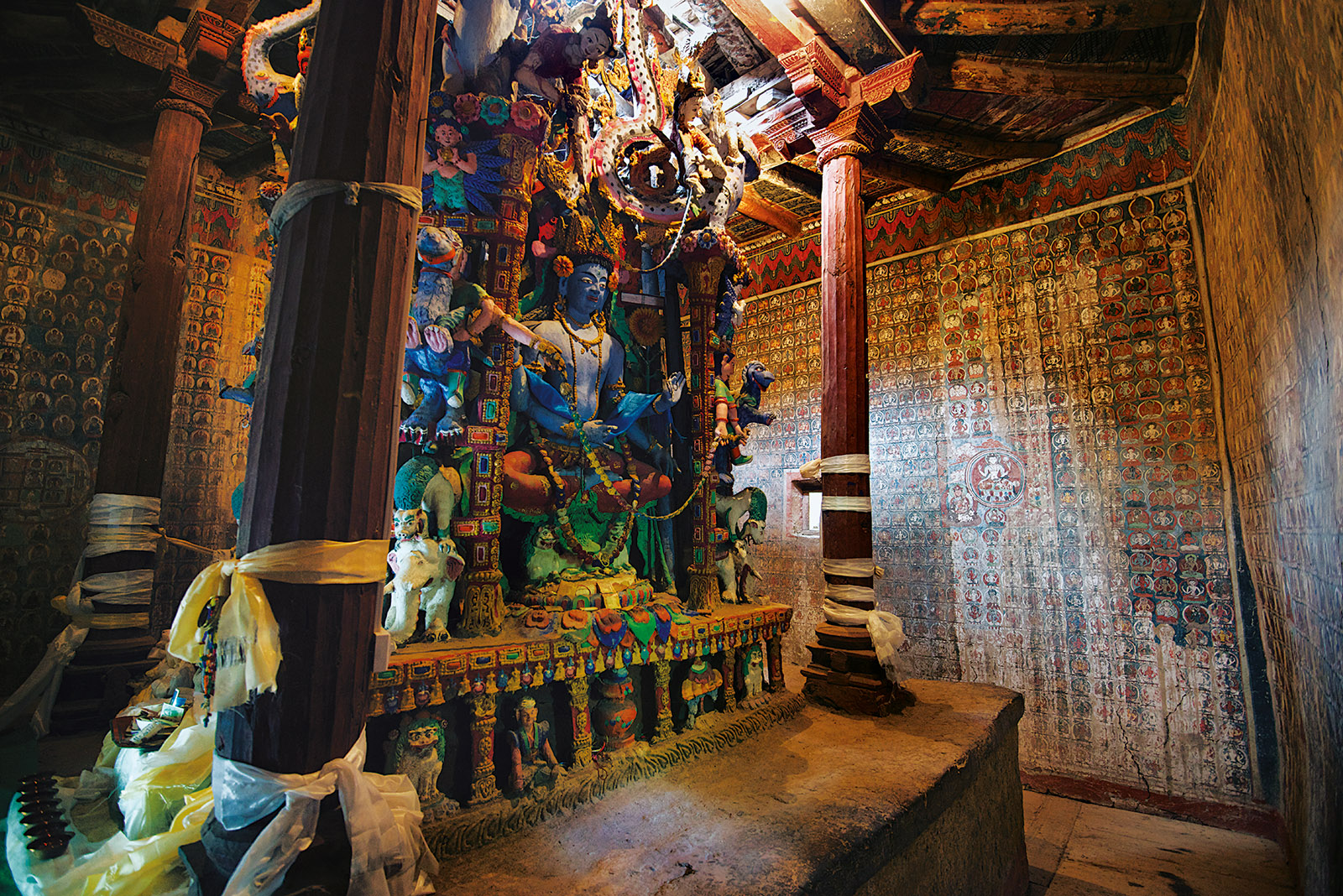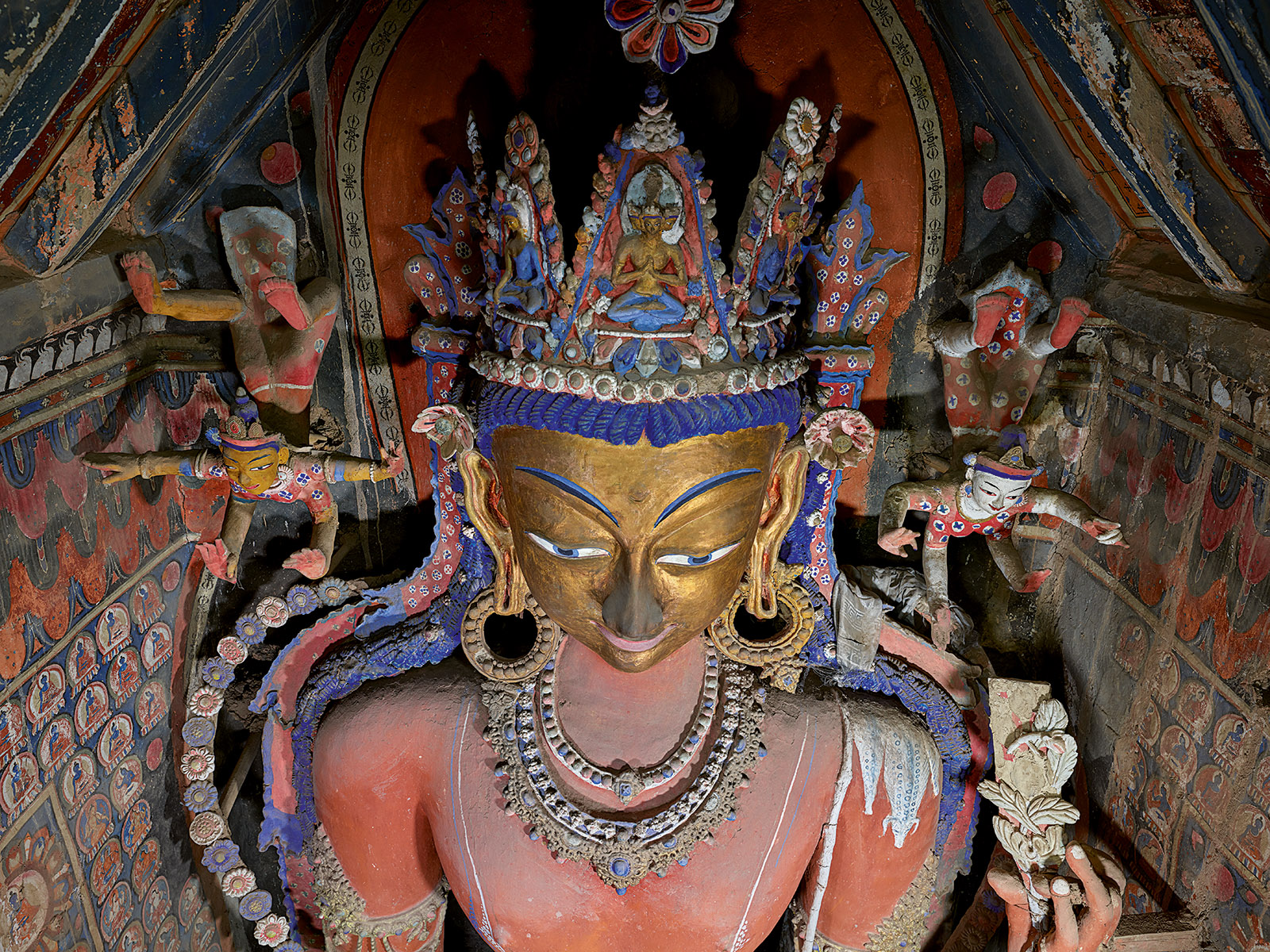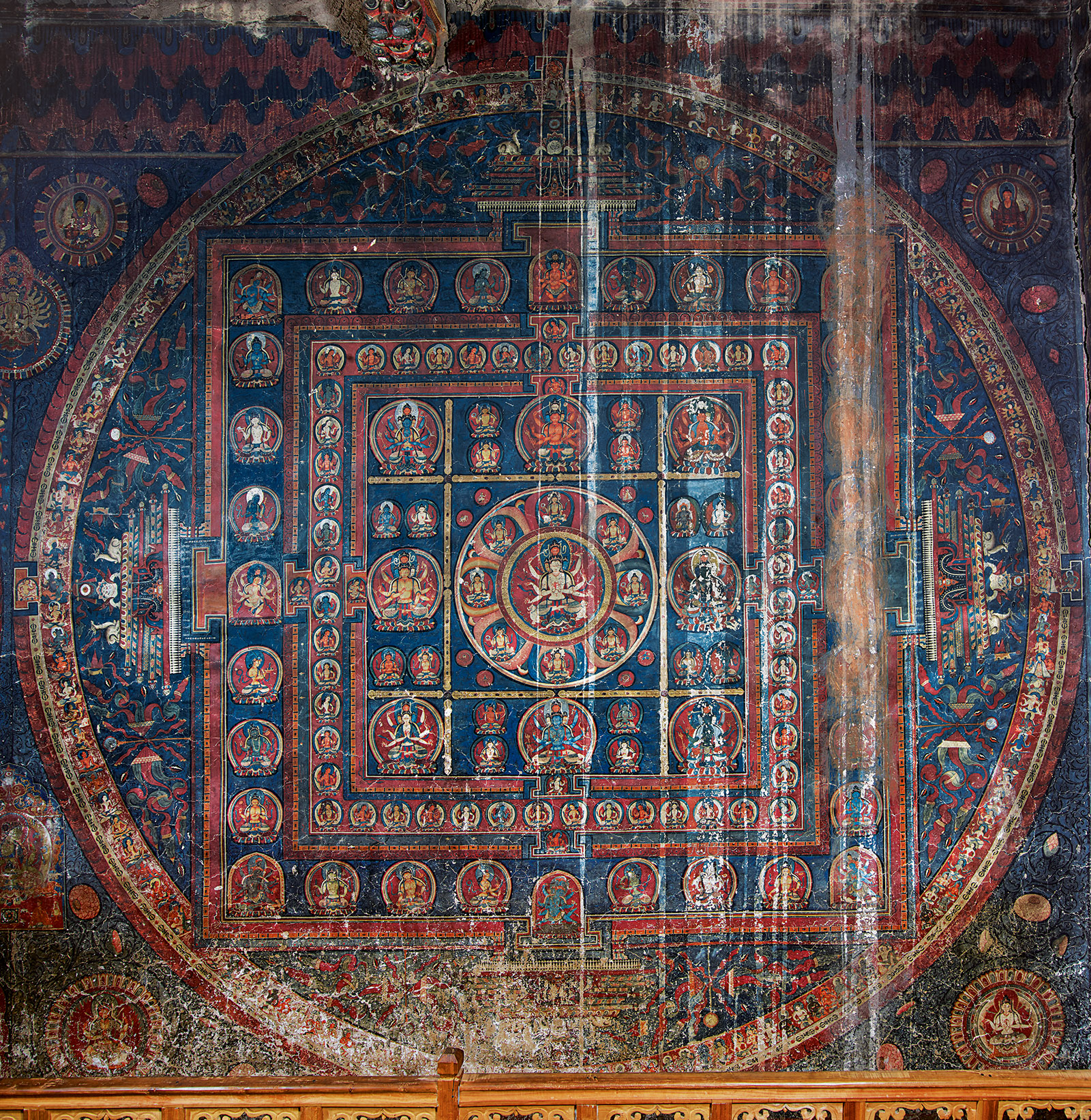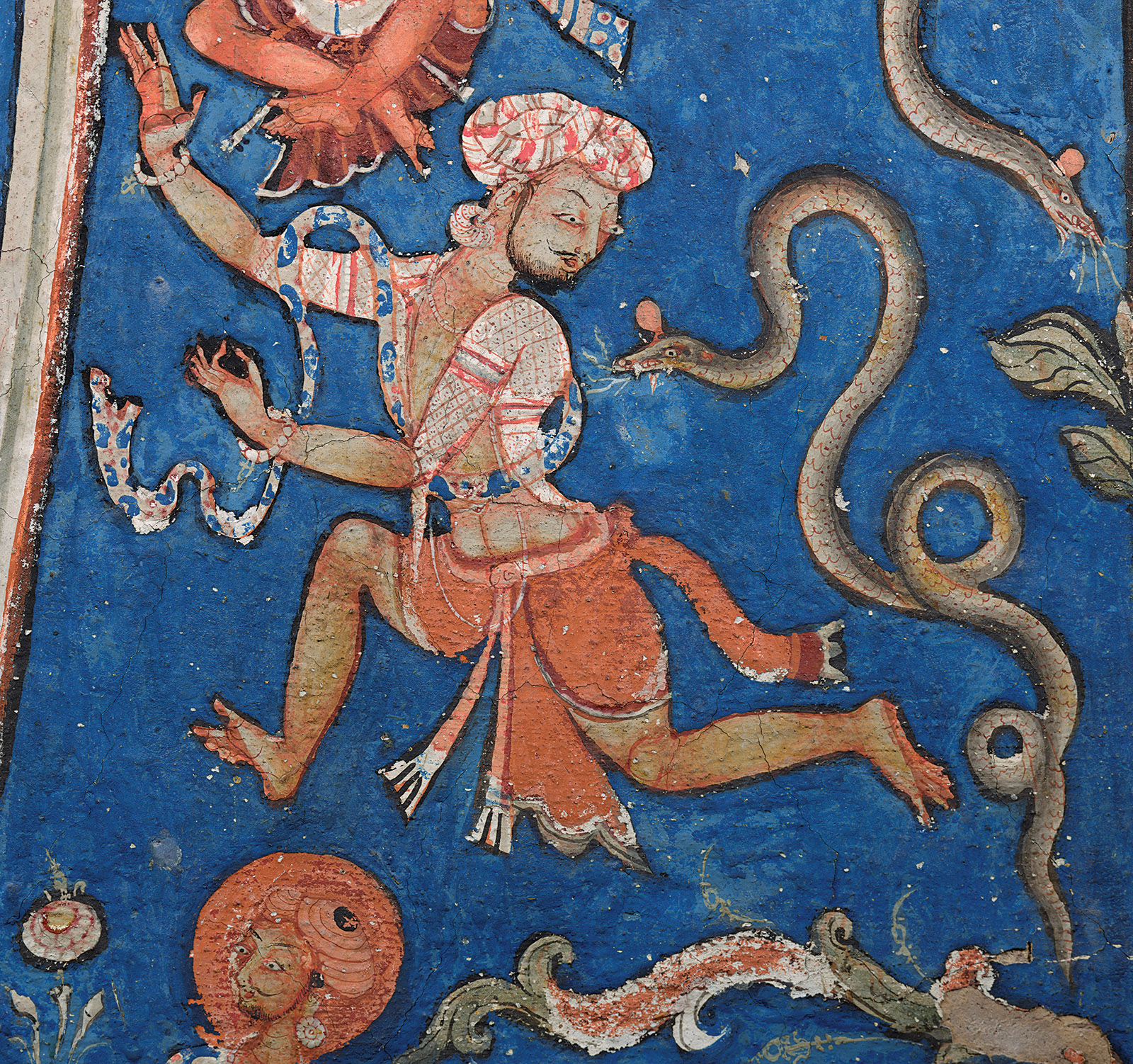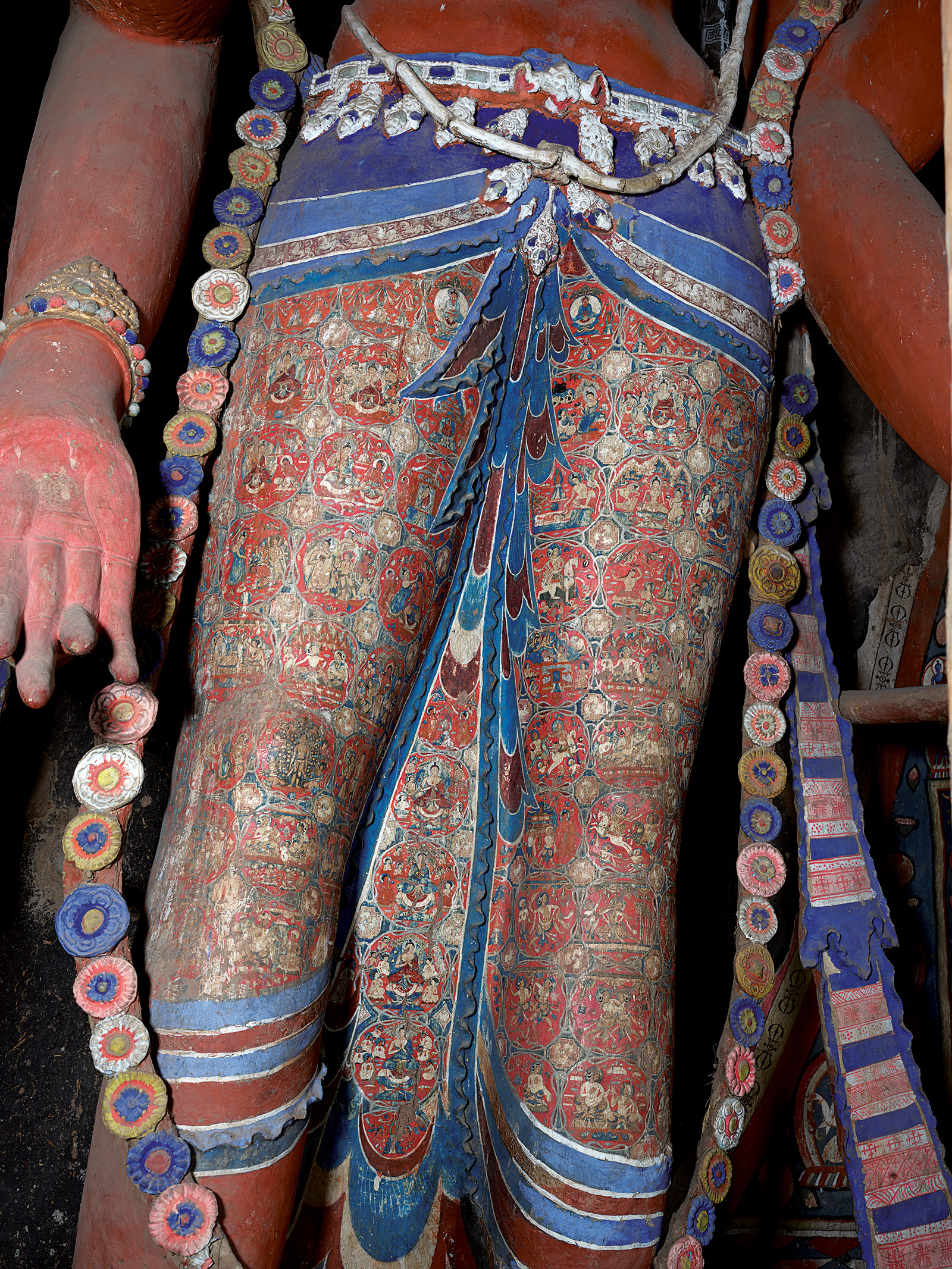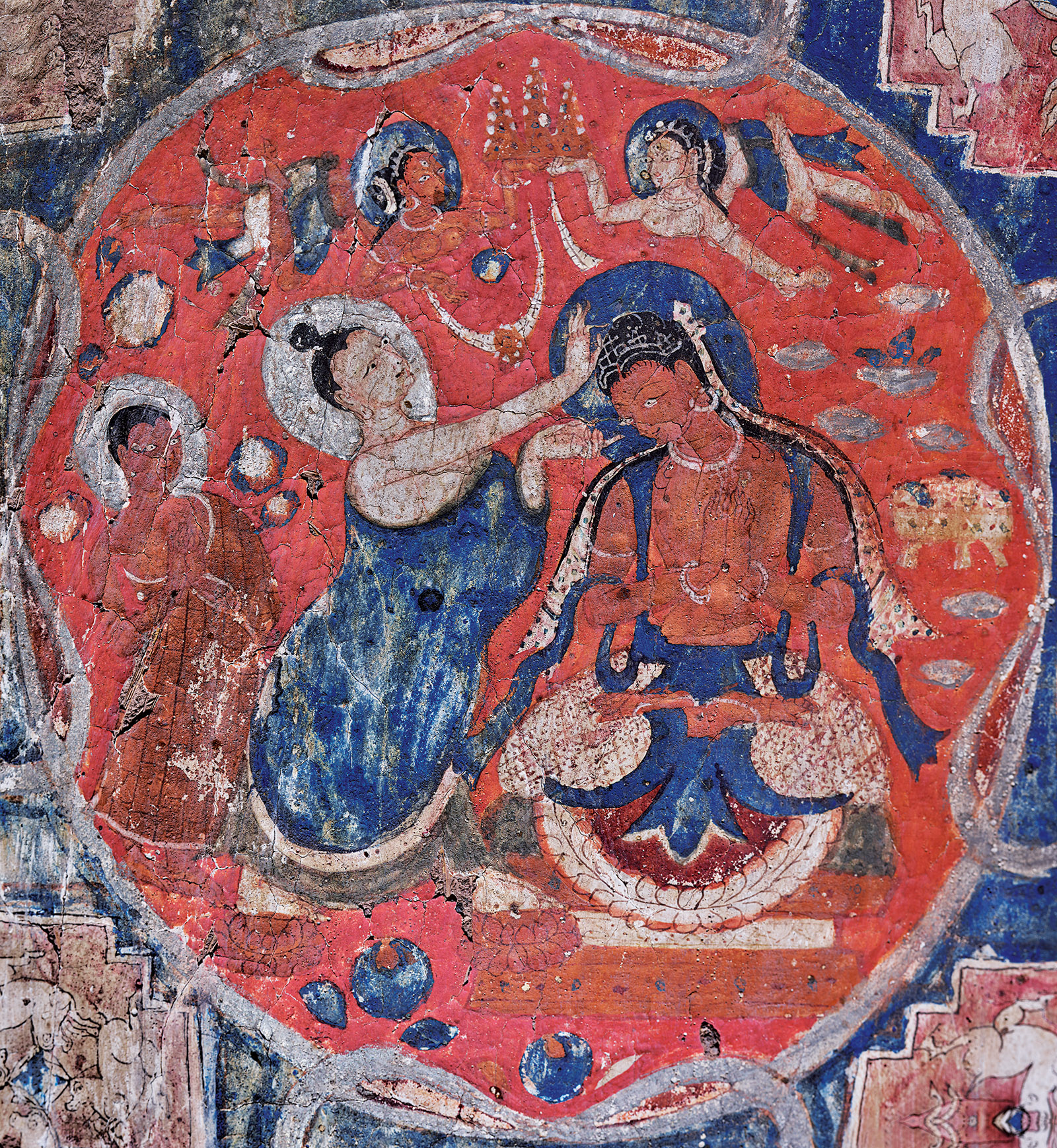Peter van Ham’s Alchi, the third volume of a monumental trilogy published by Hirmer on the Buddhist art of western Tibet, must be one of the finest art books ever produced. Its subject, the site of Alchi, sits on the bank of the Indus River in Ladakh, in the high mountain ranges to the east in what is now the Indian state of Kashmir, some thirty-five miles northwest of the capital city of Leh. Unlike Guge, the subject of van Ham’s second volume, Alchi is relatively accessible—good roads now connect Alchi to Leh and (a little less smoothly) to the haunting monastery of Lamayuru, still farther to the north and west.
I visited there with my wife in 2004. A caretaker monk unlocked for us the eleventh-century carved doorway to the Dukhang, every inch of which is painted with Buddhas, Buddhas-to-Be, gods, goddesses, demons, hungry ghosts, imps, flying nymphs, other celestial beings, royal hunters and patrons, monks, Yogi magicians, and many hallucinatory figures that seem to have floated up from the stuff of our dreams. The monk was bored and impatient; after some thirty minutes, he shooed us away. Needless to say, we had no time to unravel even one of the painted tableaux. But I was left, then as now, after spending some weeks with van Ham’s book, with a sense of a dizzying proliferation of vital beings mobbing my eyes. In all of South Asian art, there is nothing quite like these densely painted murals.
As in van Ham’s previous two volumes—Tabo—Gods of Light (2014) and Guge—Ages of Gold (2016)—van Ham’s photographs provide definitive documentation of the sites along with a relatively sparse text identifying each item in the complex iconographic program followed by the painters and sculptors. To get an idea of what this means, look, for example, at the mandala named for the Buddha of Ultimate Wisdom, Manjushri (the technical name for this particular meditative configuration is Dharmadhatu Vagishvara Manjushri Mandala, that is, “the circular cosmos of the deity of wisdom, lord of sound, in his essence of being”). This single mandala encompasses 280 figural images, each specified, named, and ordered according to a program of disciplined visualization in stages and levels aimed at changing things—maybe all things—in the meditator’s mind. And this is only one of the enormous diagrams that fill the walls of the Alchi shrines.
Van Ham’s profound knowledge of Tibetan art and iconography guides the reader through these labyrinthine recesses and multicolored geometric designs; the Tibetologist and art historian Amy Heller introduces the epigraphic records that tell us, among other things, of the aristocratic monks Kaldan Sherab and Tsültim Ö, who founded the two major shrines at Alchi, the Dukhang congregation hall and the adjacent three-tiered building, or Sumtsek, respectively. Together, these two buildings contain the acme of early western Tibetan art.
Some of the Alchi treasures have been photographed before, and there have been important studies of the site by David Snellgrove and Tadeusz Skorupski (The Cultural Heritage of Ladakh, 1977), Pratapaditya Pal and Lionel Fournier (A Buddhist Paradise: The Murals of Alchi, 1982), and Roger Goepper and Jaroslav Poncar (Alchi, 1996), among others. But it must be said that no one before van Ham has been able to document the whole of the Alchi monastic complex, image by image, inch by inch. He was lucky—or blessed with exceptionally good karma from his former lives—to get the support of Nari Rinpoche, the brother of the Dalai Lama, and ultimately the consent of the Likir Monastery, which administers the site. Working in extremely challenging conditions, particularly in the narrow, almost unreachable second and third stories of the Sumtsek, van Ham put together a masterpiece. The true achievement, however, lies not merely in the completeness of the photographic record but—as with his previous books—in his ability to convey the interlacing layers of light and shadow, the uneven textures of surface and color, and the emotional punch these images from a thousand years ago are still able to deliver, even to a viewer who knows nothing of Buddhist iconography and ritual practice.
The major temples at Alchi were built in the final years of the eleventh century or, at the latest, the first decade of the twelfth. Lavish royal patronage was involved; this was a period when the Guge kings were extending their control westward and northward into Ladakh (one has to forget the modern nation-state boundaries in order to understand the politics of twelfth-century Nari Khorsum, the vast western Tibetan kingdom flourishing at that period). A major figure linked to this process was the translator Rinchen Zangpo, who is supposed to have urged the Guge king Ö De to move to Ladakh (circa 1024) and who produced Tibetan versions of many canonical Sanskrit works, also transmitting the Tantric texts that shaped the iconography of the Alchi site. These texts, discussed in my earlier review of Guge, offer detailed descriptions of the elaborate mandalas focused on the Buddha of Light, Vairochana, his close counterpart and companion Manjushri, the Wisdom Buddha, and the Buddha Still to Come, Maitreya, the Compassionate Friend. Huge painted clay images of the latter two Buddhas stand on the ground floor of the Sumtsek, along with the white Bodhisattva Avalokiteshvara, much beloved of the Tibetans. Maitreya, taller than the other two, occupies the center.
Advertisement
The painted mandalas were meant not simply to take the visitor’s breath away, though that is what they do, but to serve as templates for meditative visualization. Monks adept in the practice enter into the mandala, noting (or, more precisely, generating) as they penetrate ever deeper the sparkling array of Buddhist divinities that are there to greet and accompany them on their way. In some sense, the adept transforms himself into the Buddha of Light—according to teaching, literally, not metaphorically—and thus comes to occupy, as a form of Vairochana himself, the glowing bodily center of this highly patterned Buddhist universe.
Each new mandala offers another arena in which to practice this art of becoming, as the Tantric texts tell us. But all of these mandala worlds are predicated on the root principle of emptiness, the void out of which phenomena emerge and into which they continually dissolve. Van Ham thus nicely titles his section on the great carved doorway of the Dukhang “Entering the Path to the Void.” One could also describe the meditative praxis proper to these temples as one of continuous emptying and filling: the self, or the mind, is drained of its illusory solidity and replaced by no less illusory, yet profoundly liberating, Buddhas and Buddhas-to-Be.
Alchi is such interiority gone wild. Exquisite visions pop up everywhere you look, and not only on the walls. And these finely calibrated beings are in movement—however stable, fixed in attribute and position, they might seem to a casual eye. They tend to merge or overlap with one another, so that the exuberance of shape and color repeatedly reveals worlds emerging within worlds, gods within gods, temples within temples, time within time (and so we have, for example, the still-living Buddhas of the Fortunate Era, the Bhadrakalpa). To describe these processes adequately would require a new language, one free from even residual traces of a representational notion of seeing and meaning.
Not surprisingly, the painters have also left us images of craftsmen, artists, and musicians at work, as in the highly unusual panel of a Greek-Indo-Iranian fire god, perhaps akin to the Vedic Agni or to the eastern Iranian deity Athosho. Deities borrowed from the Hindu pantheons of India—Yamantaka, the God of Death; Naga serpents, male and female; the great goddess Parvati and many of her counterparts and rivals—are regular “guests,” as van Ham calls them, in the ramified iconographies enshrined on all levels of the Alchi temples.
These examples point to the marked cross-cultural influences on the Alchi painters, many of whom must have been imported by the Guge rulers from Kashmir. Iranian and Central Asian elements are particularly in evidence in depictions of clothing, in conspicuous themes and motifs, and in stylized decoration (hence such images as the “Parthian shot,” when an archer on horseback turns backward in his saddle to shoot a lion; Iranian lion rondels; a largely Sassanian royal drinking scene). But there are also Mediterranean and Far Eastern influences on this Inner-Asian art. Twelfth-century Ladakh, separated by the Himalayan, Kunlun, and Karakorum ranges from other parts of the world, was unexpectedly cosmopolitan, porous to the traditions, both artistic and intellectual, of the several branches of the Silk Road. I think it likely, for example, that these Tibetan Vairochanas owe something to the Iranian theme of the cosmic Man of Light, now thoroughly reconceived in a Buddhist cosmology of radiant perception.
As in Tholing in Guge, we meet here the five-fold sequence of Buddhas, or Buddha-families, centered on Vairochana in his four-headed manifestation, as befits his epithet, Sarvavid, All-Knowing. Each of these Buddhas has his female partner (thus pairing insight and instrumental means, in the language of the texts); and their entourage, located in outer circles and squares of the mandala, includes sixteen Bodhisattvas or future Buddhas, four goddesses of the inner offering, another set of sixteen Bodhisattvas, four goddesses of the outer offering, and gatekeeper figures at the points of entry into the circle. Except for the inner Buddhas, all of these figures carry a sword in the right hand, ostensibly to help the meditator cut through the ignorance endemic to the human mind, or perhaps because true insight rarely comes without terror.
Advertisement
One striking feature at Alchi is the surpassing beauty of the seemingly endless array of goddesses, of many colors, some with wonderful names such as Firebrand of Diamond and Wrinkled Brow. Loveliest of all is the blue-green Tara, the benevolent goddess who carries all who worship her across the oceans of sorrow (also across ordinary lakes, rivers, and mountain streams). A unique panel painted on the second story of the Sumtsek, known to the texts as the “Mandala of the Adamantine Mystery,” converts all the male deities, including the Buddha Vairochana himself, into their corresponding, elegant female forms. All of these divinities can be summoned and made present—in effect, created in the mind—if one knows the proper mantras that give them life and breath. Listening to the mantras, adepts can hear these gods before they see them. In this Adamantine Mystery, the sonic invocations, dharanis, appear embodied and personified in feminine form.
Some of the most remarkable images are located on the dhotis—the waist cloths—worn by the massive clay images mentioned above. The entire narrative of the historical Buddha, Shakyamuni, based largely on the Sanskrit Lalitavistara, or “Charming Dilation,” is depicted in miniature on the dhoti of Maitreya, the Buddha Still to Come (again, the motif of Buddhas within Buddhas). In over fifty medallions, we see Shakyamuni in the Tushita Heaven, instructing Maitreya about the latter’s ultimate, redemptive role; then the birth of Prince Siddhartha in Kapilavastu, his overly protected childhood, and his shock at learning that illness, old age, and death are parts of life; his escape from the royal palace, his spiritual experiments in the wilderness, and the climactic moment of his enlightenment. Here, past fuses with future seen on a human time scale; and this association of the messianic Maitreya with the heroic founder figure fits well with the central position Maitreya occupies in the Sumtsek. The figure of the Compassionate Friend was a favorite of the Guge kings, as we see in the Golden Maitreya temple one of them, Lha De, founded at Shey, not far from Leh and the great shrines of Nyarma.
Although the progression from one immense painted mandala to the next allows for several possible readings of what the Alchi painters had in mind (in this regard, a map of the walls and their primary icons would have been a useful addition to the book), I think a fuller understanding of Alchi, indeed of western Tibetan art in general, requires a broad vision that would extend to the Tantric Buddhist monuments of Southeast Asia, especially the early-ninth-century Borobudur in central Java, probably the greatest and most mysterious Buddhist monument in the world. Borobudur highlights the future Buddha and the house of infinite mirrors where he lives. Indeed, it is possible that Borobudur was planned and built at least in part as a ritual device for bringing Maitreya to earth or reconstituting him in visible form and thus accomplishing the end of days—either in our world or in the pilgrim’s primed and disciplined mind. Java is far from Ladakh, but we have textual hints of links between them in this period; I can’t help wondering if Alchi has absorbed, as a part of its ritual and meditative structure, something of this earlier, radically millenarian doctrine. Or perhaps Maitreya has already come and now resides on the banks of the Indus.
It isn’t easy to paint emptiness. It’s even harder to perceive the void shimmering and beckoning from within the plethora of figures that swirl before our eyes. Harder still would be to photograph such a painting without reducing its expressive power. But Mahayana Buddhism tells us that emptiness is not in any sense outside our own, visible world. Just here—in the constant process of vanishing and re-emergence—lies the infinite beauty of the world. At the heart of van Ham’s artistic enterprise is his uncanny gift for showing us, in the paintings he has photographed, this continuous, ravishing evanescence. Once one takes in this truth of transience and sees, with open eyes, its logic and inherent wonder, the most remarkable feeling of freedom and happiness sets in.
Alchi—Treasure of the Himalayas, by Peter van Ham, with Amy Heller and Likir Monastery, is published by Hirmer Verlag.


